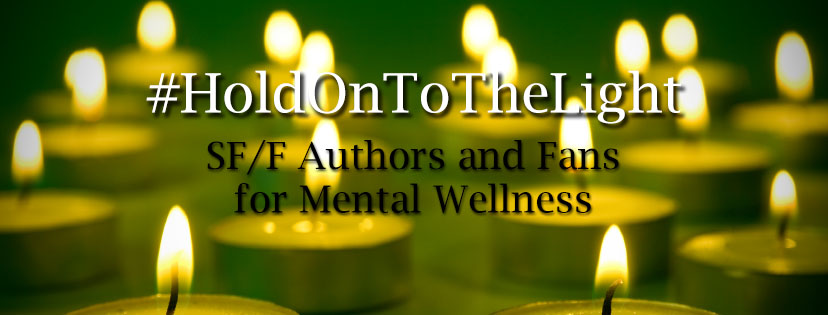
I honestly don’t know where this post is going, and so please bear with me as I work through my tangled thoughts.
I am struck today — as I ponder a life that is both fraught and wonderful, complicated and strikingly simple, weighted with deep worries and buoyed by simple yet profound pleasures — by the oddity of the things we choose to care about minute to minute, day to day, year to year.
As many of you know, last year our daughter was diagnosed with cancer. Her initial treatments went well, her maintenance regimen has been harder to pin down and she recently had a small setback — minor, but with cancer nothing is truly minor.
I suffer from anxiety anyway, and so any change for the worse in her situation can send me into a tailspin. The truth is, lots of things, big and small, can send me into a tailspin, but I am hardly unique in that regard. And when it comes right down to it, I am not convinced my anxiety explains the emotional phenomena with which I’m grappling in today’s post.
Perhaps an example will help me clarify my topic and allow you to follow along as I muse and ponder. I find — and this is nothing new — that one moment I can be focused on my daughter’s health, or something else of equal importance and solemnity, and the next I can be completely put out by my inability to solve the day’s Wordle puzzle in four guesses instead of five. A frivolous, even absurd, example to be sure, but I offer it in all seriousness. The frivolity is kind of the point.
This has been a difficult couple of years to say the least. I often begin my morning walks mired in dark thoughts, consumed with worry about my kid, or the state of the world, or, for a long time, the persistence of the pandemic. And then I will spot a hawk along the trail, or a warbler will pop up and start to sing in plain view, and I will be filled with happiness. Fleeting perhaps, but not any less powerful for its brevity.
We can be resilient creatures, we humans. And I do think some of what I’m writing about is resilience. Part of it might be as well the simple reality that our emotions demand respite. It can be exhausting living with worry or with grief. Many of us, myself included, live with anxiety or depression or other mental health issues, and these conditions can compound that weariness. Many of us struggle to find those moments of pleasure, those glimpses of resilience.
But the fact is, our minds — or at least my mind — seem to seek out breaks from the toughest issues. How else can I explain being consumed with the threat of global climate change one moment, and truly caring who wins the Tottenham v. Manchester City soccer match the next? How can I worry about my children, or the health of my in-laws, and also care whether I solve the puzzle on my phone in the allotted sixty seconds?
Do our minds do this to preserve our sanity? Ophthalmologists tell us that we can ease strain on our eyes when sitting in front of our computers by taking a few minutes periodically to focus on something farther away. Isn’t that what our brains do, too?
Okay, so I’m nearly six hundred words in to this post, and I still haven’t figured out what the hell I want to say. I suppose I am trying to explain to myself how my own coping mechanisms work. I know that for me, constant worry is debilitating. The intrusions of the frivolous save me from myself. I care about Wordle not because it matters, but because in making it matter, I force myself to look elsewhere, to focus on something other than the hard stuff right in front of me. I allow myself the pleasure of a bird sighting — or a song well played on my guitar, or a successful photograph — because without such pleasures my world would be a bleaker place.
I suppose I am merely describing distractions, which all of us have. And perhaps what I’m actually doing, in public, and in a roundabout way, is giving myself permission to be distracted. Because, I have to admit, in the depths of my legitimate worries, I am embarrassed by the trivial things I care about. Resilience. Distraction. Fun. Pleasure. Joy. When we confront serious matters — including life and death matters — these things can feel wrong, like violations of self-imposed gravity. How dare I take pleasure in a new music CD when my kid is dealing with cancer. How dare I care about a soccer match, or a Wordle puzzle, when the world is in crisis.
The thing is, though, without all those pursuits that delight and distract and bring joy, why does anything else matter? We help no one when we deny ourselves simple pleasures. Because they not only are born of resilience, they also promote it. And without resilience we are of no use to the people who need us, to a world that demands our attention and our compassion.
Perhaps this post is one long rationalization, a way to convince myself it’s okay for me to have fun now and then. But I think it’s more. In the depths of difficult times, I believe we need to remind ourselves to take joy when and where we can. Life is hard. We face no shortage of excuses to be sad or frightened or angry. Our humanity demands we also create opportunities to find happiness and peace, even if just for a short while.
Wishing you wonderful week.









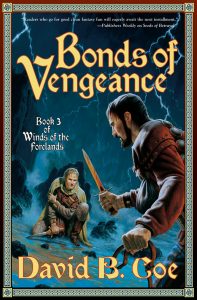 Honestly, I think “trust yourself” is good advice for life in general, but for me, with respect to writing, it has a specific implication. It’s something I heard a lot from my first editor when I was working on my earliest series — the LonTobyn Chronicle and Winds of the Forelands.
Honestly, I think “trust yourself” is good advice for life in general, but for me, with respect to writing, it has a specific implication. It’s something I heard a lot from my first editor when I was working on my earliest series — the LonTobyn Chronicle and Winds of the Forelands.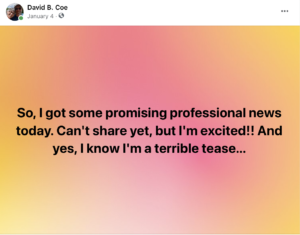 Nearly two months ago, early in the new year, I posted on social media that I had some exciting professional news I couldn’t share quite yet. I was thrilled, and wanted to let people know. But I also didn’t want to say anything before all the details had been settled. So I posted my little teaser, forgetting the one immutable rule of the publishing business: Things always happen slower than one thinks they will.
Nearly two months ago, early in the new year, I posted on social media that I had some exciting professional news I couldn’t share quite yet. I was thrilled, and wanted to let people know. But I also didn’t want to say anything before all the details had been settled. So I posted my little teaser, forgetting the one immutable rule of the publishing business: Things always happen slower than one thinks they will.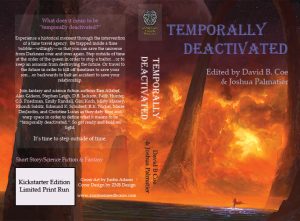 Since writing it, though, I have become sort of fixated on the idea. I am editing my fourth anthology, and already looking at the possibility of editing another. My freelance editing business is attracting a steady stream of clients — I’m booked through the spring and have had inquiries for slots later in the year.
Since writing it, though, I have become sort of fixated on the idea. I am editing my fourth anthology, and already looking at the possibility of editing another. My freelance editing business is attracting a steady stream of clients — I’m booked through the spring and have had inquiries for slots later in the year.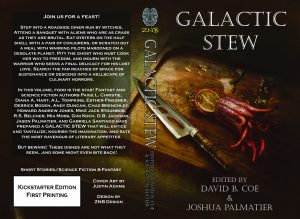 I am not an acquiring editor. I do decide, along with my co-editor, whose stories will be in the anthologies I edit, so I suppose in that way I am determining the fate of submissions and, in a sense, “buying” manuscripts. But, for now at least, I don’t make decisions about the fate of novels, and so I don’t have to go toe-to-toe with agents. Good thing. They scare me. (Looking at you, Lucienne Diver.)
I am not an acquiring editor. I do decide, along with my co-editor, whose stories will be in the anthologies I edit, so I suppose in that way I am determining the fate of submissions and, in a sense, “buying” manuscripts. But, for now at least, I don’t make decisions about the fate of novels, and so I don’t have to go toe-to-toe with agents. Good thing. They scare me. (Looking at you, Lucienne Diver.)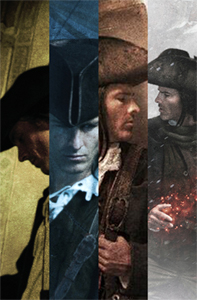 I am not the most talented writer I know. Not by a long shot. I am good. I believe that. My character work is strong. My world building is imaginative. My prose is clean and tight and it flows nicely. I write convincing, effective dialogue and I have a fine eye for detail. My plotting and pacing, which were once just okay, have gotten stronger over the years. I think writing the Thieftaker books — being forced to blend my fictional plots with real historical events — forced me to improve, and that improvement has shown up in the narratives of the Islevale and Radiants books.
I am not the most talented writer I know. Not by a long shot. I am good. I believe that. My character work is strong. My world building is imaginative. My prose is clean and tight and it flows nicely. I write convincing, effective dialogue and I have a fine eye for detail. My plotting and pacing, which were once just okay, have gotten stronger over the years. I think writing the Thieftaker books — being forced to blend my fictional plots with real historical events — forced me to improve, and that improvement has shown up in the narratives of the Islevale and Radiants books.
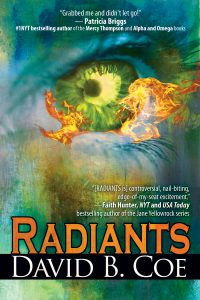 8. You read
8. You read 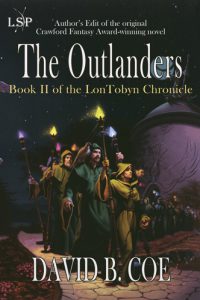 The Outlanders, my second book, may well be the most significant of all the books I’ve published. I knew I had it in me to write one book. But when I finished The Outlanders, and realized it was even better than CofA, I knew I was more than a guy who could write a novel. I was an author. And when Children of Amarid and The Outlanders together were given the Crawford Fantasy Award by the IAFA (International Association for the Fantastic in the Arts), for best fantasy by a new writer, I knew I would have a professional career beyond that first series.
The Outlanders, my second book, may well be the most significant of all the books I’ve published. I knew I had it in me to write one book. But when I finished The Outlanders, and realized it was even better than CofA, I knew I was more than a guy who could write a novel. I was an author. And when Children of Amarid and The Outlanders together were given the Crawford Fantasy Award by the IAFA (International Association for the Fantastic in the Arts), for best fantasy by a new writer, I knew I would have a professional career beyond that first series.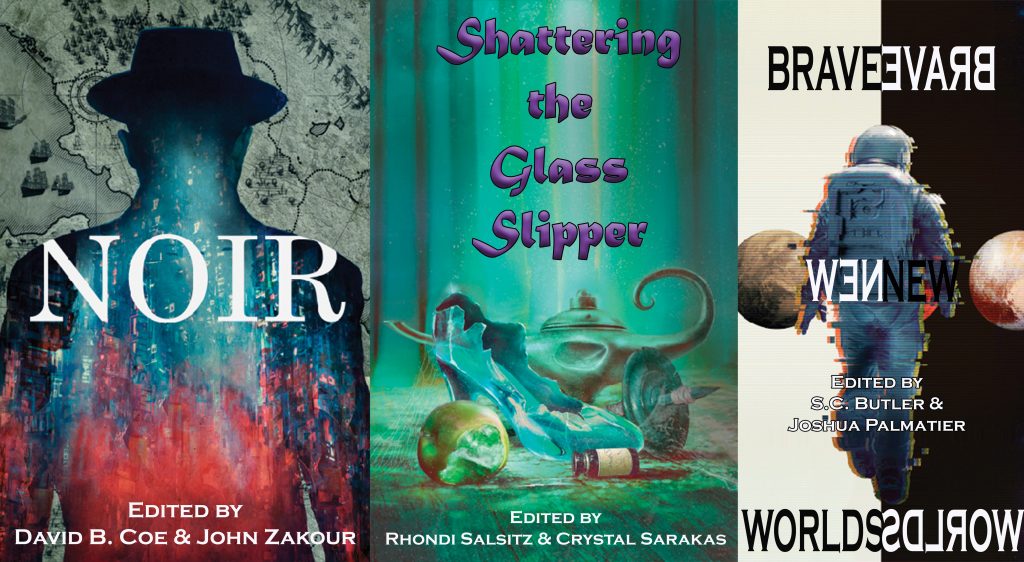 As many of you know, I am once again co-editing an anthology for
As many of you know, I am once again co-editing an anthology for  I did just that. I started with some short stories that have never since seen the light of day, but which helped me to shape the contours of my world and its history. Then I began work on the novel, and by September had completed the first five chapters of what would eventually be Children of Amarid, my first published novel. I gave the manuscript to a friend of the family who had been a publisher, and he agreed to act as my agent, operating under standard agenting fees. He sent those five chapters and an outline of the rest of the book to various fantasy publishers.
I did just that. I started with some short stories that have never since seen the light of day, but which helped me to shape the contours of my world and its history. Then I began work on the novel, and by September had completed the first five chapters of what would eventually be Children of Amarid, my first published novel. I gave the manuscript to a friend of the family who had been a publisher, and he agreed to act as my agent, operating under standard agenting fees. He sent those five chapters and an outline of the rest of the book to various fantasy publishers.